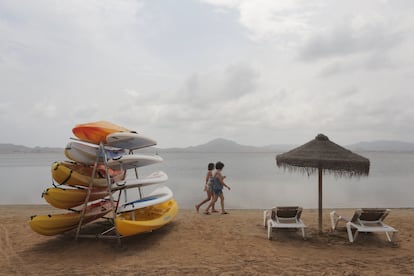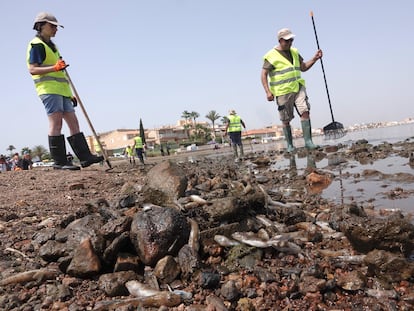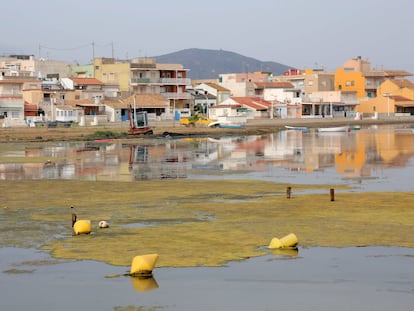Locals mourn the disaster at Mar Menor: ‘How could they let something so beautiful end up like this?’
Patience is wearing thin among residents and visitors alike, as more than 4.5 tons of dead fish wash up in the saltwater lagoon due to the surge in nutrients from agricultural fertilizers


The Mar Menor is dying. That’s the impression that nearby residents of the saltwater lagoon in Murcia, as well as people there on vacation, are being left with given the thousands of fish that have been washing up dead in recent days. “This used to be crystal clear water, a coastal lagoon, with no nutrients, and look at it now,” complains Eulalia Rubio, as she wades into the water in the Pino bay to demonstrate the green water that almost immediately engulfs her feet.
This is one of the seven areas in the Mar Menor where the red flag is flying, meaning that there is no swimming allowed. The prohibition is in place due to the environmental disaster currently taking place at the saltwater lagoon, the largest of its kind in Europe. So far, workers have removed 4.5 tons of different fish, who died due to the presence of nutrients from intensive farming and the resulting lack of oxygen in the water.
The appearance of dead fish over this last week has sparked a new wave of criticism from locals toward the politicians
The cloudy weather and the calm waters on Monday made bathing an attractive option, but the sand is empty and just a few people are to be seen taking a walk. José Juan is here with his dog, who is taking a dip, but his owner has not been into the Mar Menor “for years.” He’s lived in the area since 1985. While he looks at the lagoon, which is still brimming with small fish that can be caught by hand, as they struggle with a lack of oxygen, he says he is unable to sum up how how he feels. “There’s no way to describe this,” he laments. “I’ve seen the deterioration right from the start, it began in the 1990s when the jellyfish that fed off the nitrates started to appear,” he explains. He is calling for some “common sense,” and that people demand responsibility from local politicians with their votes. “How can they have let such a beautiful lagoon end up like this?” he asks.
The appearance of dead fish over this last week has sparked a new wave of criticism from locals toward the politicians. This is the second such major episode since October 2019, when three tons of dead fish were removed. That time around, a major flood brought with it a mass of fresh water as well as contaminated sediments. This was combined with the already poor state of the lagoon, which measures 17,000 hectares.
This time, there was no need for any meteorological phenomena to contribute to the chronic state of the Mar Menor; the constant arrival of nutrients from fertilizers has been contributing to the growth of algae and other microorganisms that consume oxygen and block the light. This is the scenario that has led to the appearance of 4.5 tons of dead fish so far.
In the wake of criticism from the locals, the regional premier of Murcia, Fernando López-Miras of the conservative Popular Party (PP), has laid the blame with the central government, which is run by a coalition of the Socialist Party (PSOE) and leftist Unidas Podemos. “We cannot allow this inaction to continue for a minute longer,” he said on Friday at a press conference. He called for powers over coasts and basins to be transferred to his government, which would allow it to take action at the aquifer and watercourses that are delivering the fertilizers and nutrients from farming into the Mar Menor.
The worst example of this is the Albujón, which brings with it 30 million liters of fresh water and five tons of nutrients to the lagoon every day. The regional government also wants to drain the Marchamalo artificial canal, which connects the lagoon with the Mediterranean Sea, given that it is full of sediment. This measure has, however, been thrown into doubt by the experts, who question the effect this could have on the already-contaminated Mediterranean Sea itself.
While they await solutions, locals such as teacher Victoria Sánchez-Bravo explain that they have lost “all hope” of remaining in their homes
The central government’s minister for environmental transition, Teresa Ribera, is due to visit the area on Wednesday, and has already sent a letter to López Miras in which she has offered to “deal with this issue personally” with him and his colleagues. In the missive, the minister responded to the criticism of the regional government, stressing her “total commitment to the restoration of the area.” But she also warned that “none of these measures will have any effect if the surge of nitrates in the Mar Menor is not immediately halted.” She also called on López Miras to “immediately” resolve the sanctions that have already been issued by the CHS state regulator in Murcia, as well as the results of inspections and injunctions imposed by Civil Guard nature protection service Seprona and the public prosecutor.
In the meantime, while they await solutions, locals such as teacher Victoria Sánchez-Bravo explain that they have lost “all hope” of remaining in their homes. She has placed her property, which is located next to the Alemanes beach, up for sale. “I bought it so that my two children and 16 grandchildren could enjoy it, but they’ve not been able to bathe here for two years,” she explains.
A few meters away, at the Pata Palo beach bar, the owner, Andrea Ramírez, complains that bookings are being canceled. “Last year it was because of the virus, and now this,” she laments. Today there is just one table reserved. “It’s shameful. Not just for us, for the businesses, but also because of the state of the sea.”
The dead fish have been springing up since last week like some kind of plague on the sands of Cartagena. “Today they’ve appeared even further, next to the outlet of the mouth of the Veneciola [in reference to one of the connection points between the lagoon and the sea] around 15 kilometers to the north of the Manga del Mar Menor,” explains Isabel Rubio, a member of the citizen campaigning group Pacto por el Mar Menor (or, Deal for the Mar Menor), which is fighting to save the lagoon. On Monday and Tuesday of last week, the first dead fish began to wash up, she explains. On Wednesday, they were found in Pino bay and by Thursday they were on the beach in front of Ciervo island. Since then they’ve not stopped appearing.
English version by Simon Hunter.
Tu suscripción se está usando en otro dispositivo
¿Quieres añadir otro usuario a tu suscripción?
Si continúas leyendo en este dispositivo, no se podrá leer en el otro.
FlechaTu suscripción se está usando en otro dispositivo y solo puedes acceder a EL PAÍS desde un dispositivo a la vez.
Si quieres compartir tu cuenta, cambia tu suscripción a la modalidad Premium, así podrás añadir otro usuario. Cada uno accederá con su propia cuenta de email, lo que os permitirá personalizar vuestra experiencia en EL PAÍS.
¿Tienes una suscripción de empresa? Accede aquí para contratar más cuentas.
En el caso de no saber quién está usando tu cuenta, te recomendamos cambiar tu contraseña aquí.
Si decides continuar compartiendo tu cuenta, este mensaje se mostrará en tu dispositivo y en el de la otra persona que está usando tu cuenta de forma indefinida, afectando a tu experiencia de lectura. Puedes consultar aquí los términos y condiciones de la suscripción digital.
More information
Últimas noticias
Tiger Woods turns 50: Will he continue playing on the PGA Tour or take a back seat?
The surreal journey of James Nnaji, the Barcelona youth player selected in the NBA Draft who ended up in the NCAA
Trump claims peace in Ukraine is near, but Moscow suggests otherwise
A survivor’s account of the Interoceanic Train accident: ‘We were scared because of the speed on the curve’
Most viewed
- Oona Chaplin: ‘I told James Cameron that I was living in a treehouse and starting a permaculture project with a friend’
- Reinhard Genzel, Nobel laureate in physics: ‘One-minute videos will never give you the truth’
- Sinaloa Cartel war is taking its toll on Los Chapitos
- Why the price of coffee has skyrocketed: from Brazilian plantations to specialty coffee houses
- Chevy Chase, the beloved comedian who was a monster off camera: ‘Not everyone hated him, just the people who’ve worked with him’










































